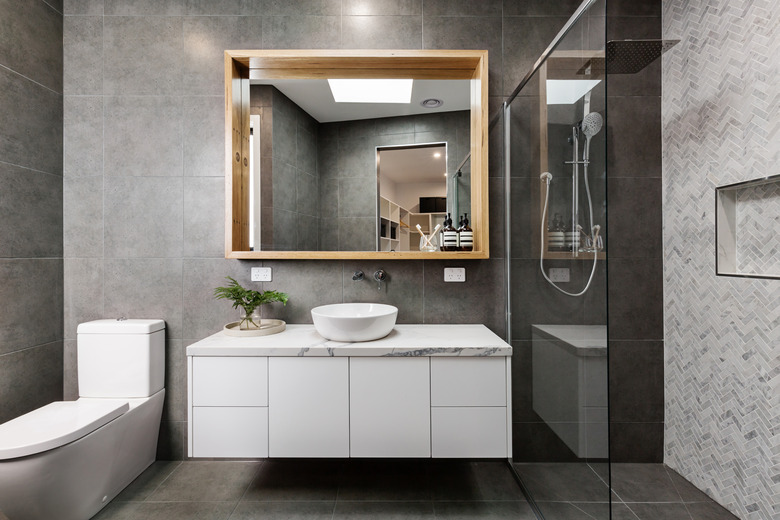How To Remove Stains On A Bathroom Vanity
We may receive a commission on purchases made from links.
A vanity unit is an important part of any bathroom. Because of its many uses, though, it can get dirty and stained over time. Stains left by hard water, toothpaste and cosmetics are a common bathroom vanity issue and can look unsightly and be difficult to remove. Knowing what your vanity is made of, along with the source of any marks or stains, is key to removing stains on your bathroom vanity.
What's Your Vanity Made Of?
What's Your Vanity Made Of?
Vanity countertops can be made of a wide range of materials. Each of these materials may have different cleaning needs, so the first step in cleaning and stain removal is knowing exactly what your vanity is made of. A plastic vanity will stand up to harsher cleaning products, whereas one made of wood may need to be treated more gently.
Being cognizant of your vanity's composition will help ensure that you can clean it thoroughly and remove any stains without causing further damage. Whatever your bathroom vanity is made of, though, it's always better to start with a gentler cleaning method first and then work your way up to something stronger if necessary.
Cleaning a Bathroom Vanity
Cleaning a Bathroom Vanity
Before you attempt any stain removal on your bathroom vanity, it's a good idea to put on your cleaning gloves and give it a deep clean. Not only will this help any stain remover to work better, but it can also remove the bulk of any surface-level marks.
A multi-purpose bathroom cleaner is a good place to start when cleaning a bathroom vanity. You can spray this over the entire area and then wipe it away with a damp cloth. For a more intense clean, you can use a tile and grout cleaner with a soft soft scrub brush. Rinse any cleanser off thoroughly and allow your vanity to dry.
Removing Hard Water Stains
Removing Hard Water Stains
Once your vanity is clean, you can get to work on any remaining hard water stains. These marks are best treated with a gentle acidic solution, which you can make naturally at home.
For a more durable vanity, such as one made of plastic, you can apply undiluted white vinegar to hard water stains using a cloth. Work the vinegar into your vanity in circular motions. Allow this to sit overnight and then rinse your vanity clean with warm water in the morning.
For a less hard-wearing vanity material, such as natural stone or glass, combine equal parts vinegar and warm water in a spray bottle. This can be sprayed on hard water stains and then left to sit for 15 minutes. Use a soft scrub brush to help work the solution in and then rinse it away using a damp cloth.
If you're struggling with extremely stubborn bathroom vanity stains, a mixture of salt and baking soda can help lift the marks away. Mix equal parts baking soda and salt with enough vinegar to create a thick paste. This paste can be applied directly to any remaining stains and then used to gently scrub the vanity to lift stains away.
To prevent future hard water stains on your vanity countertop, make sure you thoroughly dry it after use. Clean and wipe down the surface at least once a week to minimize the possibility of mineral buildup that leads to staining.
Removing Other Stains
Removing Other Stains
Aside from hard water marks, most other bathroom vanity stains are caused by the products used in the area. Makeup, toothpaste and other cosmetic stains are among the most common. Luckily, the method for removing stains left by toothpaste and other cosmetics is largely the same.
Mix equal parts water, baking soda and either hydrogen peroxide for light-colored stone-topped vanities or dishwashing liquid for darker ones, creating a paste. Apply this paste to the stain. Then cover with plastic wrap and leave for 24 hours. Remove the dried paste using a wooden utensil to avoid scratching, followed by thorough washing with mild dish soap and water.
If you have a wooden vanity top, you may need to be more careful. A paste made from 1 tablespoon baking soda and 1 teaspoon each of vinegar and water can be a great way to lift dye and other types of stains from wooden countertops, according to Signature Hardware. Rub the paste in using circular motions and wipe it away when the stain is no longer visible; repeat as necessary. You can also try baking soda, vinegar and soap, but hydrogen peroxide isn't generally recommended.
